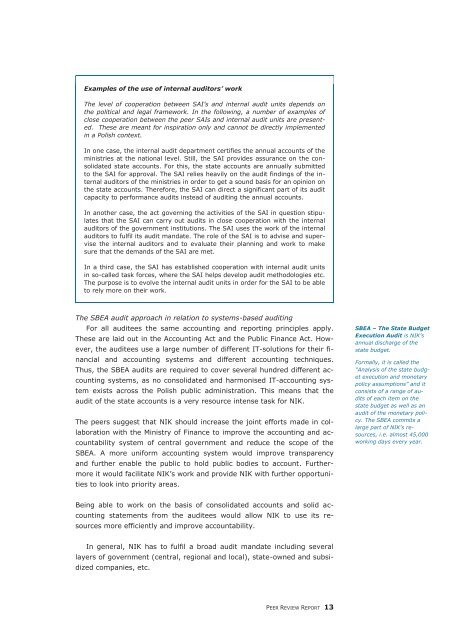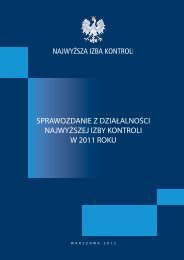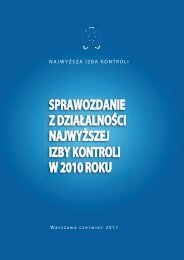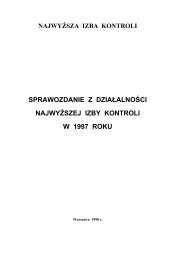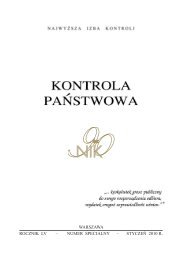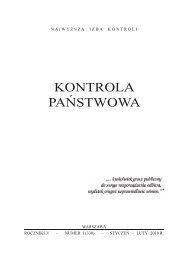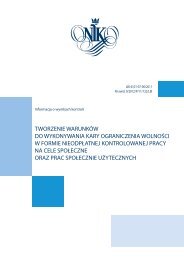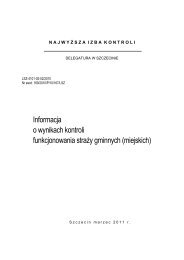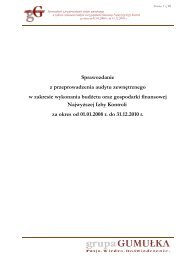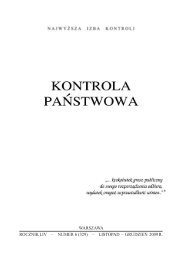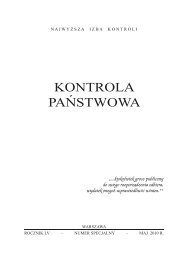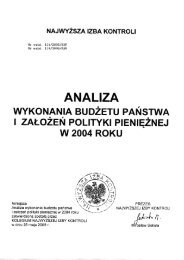NIK peer review report - Najwyższa Izba Kontroli
NIK peer review report - Najwyższa Izba Kontroli
NIK peer review report - Najwyższa Izba Kontroli
Create successful ePaper yourself
Turn your PDF publications into a flip-book with our unique Google optimized e-Paper software.
Examples of the use of internal auditors’ workThe level of cooperation between SAI’s and internal audit units depends onthe political and legal framework. In the following, a number of examples ofclose cooperation between the <strong>peer</strong> SAIs and internal audit units are presented.These are meant for inspiration only and cannot be directly implementedin a Polish context.In one case, the internal audit department certifies the annual accounts of theministries at the national level. Still, the SAI provides assurance on the consolidatedstate accounts. For this, the state accounts are annually submittedto the SAI for approval. The SAI relies heavily on the audit findings of the internalauditors of the ministries in order to get a sound basis for an opinion onthe state accounts. Therefore, the SAI can direct a significant part of its auditcapacity to performance audits instead of auditing the annual accounts.In another case, the act governing the activities of the SAI in question stipulatesthat the SAI can carry out audits in close cooperation with the internalauditors of the government institutions. The SAI uses the work of the internalauditors to fulfil its audit mandate. The role of the SAI is to advise and supervisethe internal auditors and to evaluate their planning and work to makesure that the demands of the SAI are met.In a third case, the SAI has established cooperation with internal audit unitsin so-called task forces, where the SAI helps develop audit methodologies etc.The purpose is to evolve the internal audit units in order for the SAI to be ableto rely more on their work.The SBEA audit approach in relation to systems-based auditingFor all auditees the same accounting and <strong>report</strong>ing principles apply.These are laid out in the Accounting Act and the Public Finance Act. However,the auditees use a large number of different IT-solutions for their financialand accounting systems and different accounting techniques.Thus, the SBEA audits are required to cover several hundred different accountingsystems, as no consolidated and harmonised IT-accounting systemexists across the Polish public administration. This means that theaudit of the state accounts is a very resource intense task for <strong>NIK</strong>.The <strong>peer</strong>s suggest that <strong>NIK</strong> should increase the joint efforts made in collaborationwith the Ministry of Finance to improve the accounting and accountabilitysystem of central government and reduce the scope of theSBEA. A more uniform accounting system would improve transparencyand further enable the public to hold public bodies to account. Furthermoreit would facilitate <strong>NIK</strong>’s work and provide <strong>NIK</strong> with further opportunitiesto look into priority areas.SBEA – The State BudgetExecution Audit is <strong>NIK</strong>’sannual discharge of thestate budget.Formally, it is called the“Analysis of the state budgetexecution and monetarypolicy assumptions” and itconsists of a range of auditsof each item on thestate budget as well as anaudit of the monetary policy.The SBEA commits alarge part of <strong>NIK</strong>’s resources,i.e. almost 45,000working days every year.Being able to work on the basis of consolidated accounts and solid accountingstatements from the auditees would allow <strong>NIK</strong> to use its resourcesmore efficiently and improve accountability.In general, <strong>NIK</strong> has to fulfil a broad audit mandate including severallayers of government (central, regional and local), state-owned and subsidizedcompanies, etc.PEER REVIEW REPORT 13


